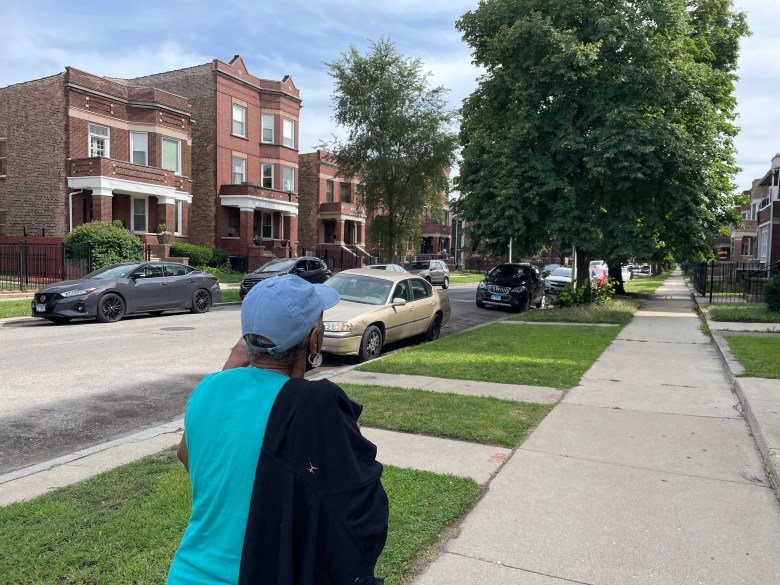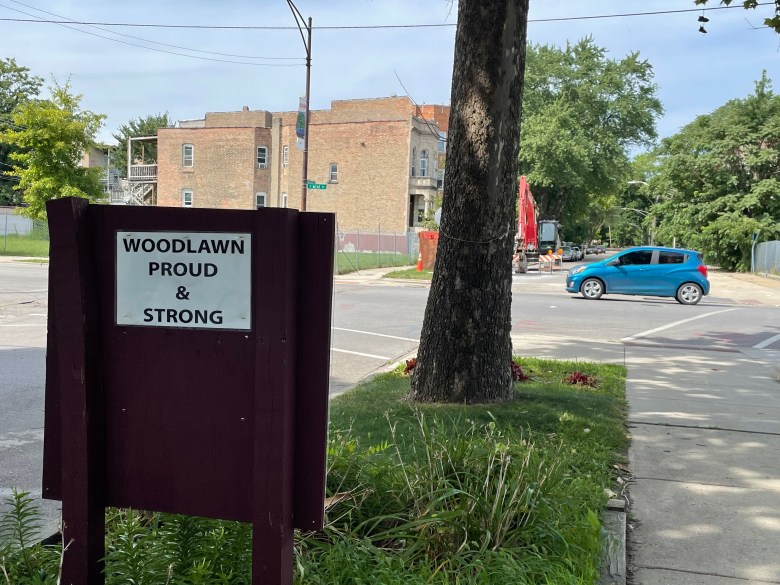
As housing prices in Woodlawn soar, longtime resident and activist Jeane Clark said she will never sell the two homes she owns on South Rhodes Avenue to anyone outside of her family.
“They’re mine,” Clark said firmly, tapping her heart twice. “They’re my legacy.”
One of the homes is the one she grew up in as a child and was purchased by her grandmother in 1943, Clark said. Both sit just a few doors down from the historic home of Lorraine Hansberry, the author of “A Raisin in the Sun” and the first Black woman to write a Broadway play. Clark grew up playing with Hansberry’s younger siblings.
“We couldn’t play too loud outside the Hansberry house because Lorraine was always upstairs writing her play,” she said.
The Hansberry house is also known for sparking the 1940 U.S. Supreme Court decision that outlawed racially-restrictive housing agreements. “A Raisin in the Sun” – a play about a working-class Black family on the South Side that tries to buy a home in an all-white neighborhood in the late 1940s – is based on Hansberry’s own experiences.
Owning a home is a vital tool for generating wealth that has been denied to Black Americans throughout history. The city of Chicago and its banks have a particularly egregious history of relegating Black residents to for-rent housing in less desirable neighborhoods by refusing to grant housing loans to Black borrowers – a practice also known as redlining.
A 2020 study by WBEZ Chicago showed that a modern form of redlining persists in Chicago today with lenders investing more in a single white neighborhood than all of the city’s Black neighborhoods combined.
To live with the reality of redlining, Black Chicagoans had to form strong, self-reliant communities on the south and west sides. Clark remembers Woodlawn as a success story in this effort, describing the area’s evolution into a “middle-class, Black neighborhood.”
Clark moved out of the neighborhood when she got married and worked as a paralegal in real estate law for a while before becoming an escrow officer for a local title company. When she bought her grandmother’s home and returned to Woodlawn in the ‘90s, Clark said she was shocked to see vacant lots and litter-lined streets.
“Why can’t we have a truly mixed-income, multiracial community that can support itself? Well, the only way to have that is to clean it up ourselves and make it happen,” Clark said.
So, she got to work, organizing neighbors to clean up the streets and help care for the yards of seniors and working mothers on the block.
Today, Clark is well known in the Woodlawn community, 20th Ward Alderman Jeanette Taylor said. She’s had a hand in raising many children who have lived on her block over the years.
“Ms. Clark does not believe in handouts but she believes in helping,” Taylor said.

As time passed and Woodlawn began to gentrify, income-restricted housing developments popped up across West Woodlawn.
“You need affordable housing because (displacement) is a problem today,” said Tito Quiñones, Clark’s neighbor. “That’s the solution for today, sure, but the solution for tomorrow is: How do we get this person out of affordable housing into a job that pays more than just to keep the lights on and get them able to actually have a stake in the community?”
In 2015, the Preservation of Affordable Housing (POAH), a national nonprofit organization, bought up land just south of Clark’s block, aiming to build more than 900 units of income-restricted housing.
“We had enough affordable housing,” Clark said. “We needed more homeowners and more middle-class people to stabilize the community.”
It was at this time that Clark and some of her neighbors formed the West Woodlawn Coalition which, at its peak, stood nearly 100 members strong, she said. The coalition had “a big, big fight” with POAH but ultimately came to an agreement when Clark came up with the idea for the Renew Woodlawn program.
Drawing upon her years of working in real estate law, Clark came up with a proposal for a homeownership program that uses grants to help people of low to moderate income purchase homes.Clark pitched the idea to POAH, which now oversees the program with the help of the Neighborhood Housing Services of Chicago and the Community Investment Corporation.
It was through this program that Quiñones, now a fellow West Woodlawn Coalition member, was able to purchase his home back in 2017.
“I see real estate as a wealth-building tool,” he said. “I want my daughter, when she turns 18, to be able to pay for school or start her business or whatever she wants to do. …We’ve got to give our kids a fighting chance out here.”
Under the Woodlawn Housing Preservation Ordinance passed in 2020, the city promised to allocate an additional $1.175 million in local and federal funds to Renew Woodlawn.
“Before I leave this earth, I would like to see this community restored to what it was when I was a girl growing up here,” Clark said.
Clark said she doesn’t want Woodlawn to be labeled as “poor,” “gentrifying,” or even “up and coming,” as her neighbor, Carol Clay, put it.
“If we all have the same mindset of helping each other and caring for the community, no one labels the neighborhood nothing but nice,” Clark said.


